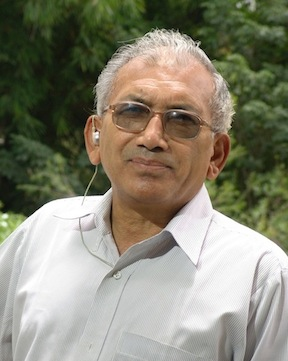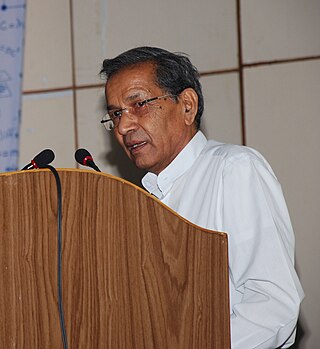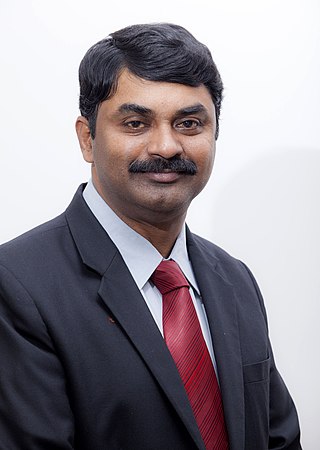Related Research Articles

The Defence Research and Development Organisation (DRDO) is an agency under the Department of Defence Research and Development in Ministry of Defence of the Government of India, charged with the military's research and development, headquartered in Delhi, India. It was formed in 1958 by the merger of the Technical Development Establishment and the Directorate of Technical Development and Production of the Indian Ordnance Factories with the Defence Science Organisation under the administration of Jawaharlal Nehru. Subsequently, Defence Research & Development Service (DRDS) was constituted in 1979 as a service of Group 'A' Officers / Scientists directly under the administrative control of the Ministry of Defence.

Haldwani is the largest city of Kumaon. It is also the third most populous city in the Indian state of Uttarakhand. Haldwani is said to be the financial capital of Uttarakhand, having the most commercial, economic and industrial activities of the state. Haldwani is located in the Nainital District, and is one of its eight Subdivisions. The Haldwani Urban agglomeration has 232,060 people as of 2011, and is the third most populous UA in Uttarakhand, after Dehradun and Haridwar. Being situated in the immediate foothills of Kumaon Himalayas, the Kathgodam neighbourhood of Haldwani is known as the "Gateway to Kumaon".
Gora Padao is an Indian village 5 km south of Haldwani is named after a British camp/post at that location in the mid-19th century. In 1856, Henry Ramsay took over as the Commissioner of Kumaon.

Daulat Singh Kothari was an Indian scientist and educationist.

Harsil is a village, tourist hill station and army area located on the banks of the Bhagirathi River, on the way to Gangotri, a Hindu pilgrimage site in Uttarkashi district of the Indian state of Uttarakhand.
Defence Research & Development Establishment (DRDE) is an Indian defence laboratory of the Defence Research and Development Organisation (DRDO). Located in Gwalior, it is primarily involved in the research and development of detection and protection against toxic chemical and biological agents. DRDE is organised under the Life Sciences Directorate of DRDO. The present director of DRDE is Dr. Manmohan Parida.
The Defence Institute of Physiology & Allied Sciences (DIPAS) is an Indian defence laboratory of the Defence Research and Development Organisation (DRDO). Located in Delhi, it conducts physiological and biomedical research to improve human performance in extreme and wartime environments. DIPAS is organized under the Life Sciences Directorate of DRDO. The present director of DIPAS is Dr. Rajeev Kumar.

William Selvamurthy is an Indian scientist, currently working with Amity University, Raipur, as President of Amity Science, Technology and Innovation Foundation and Director General for Amity Directorate of Science and Innovation. He previously served as a Chief Controller, Research & Development at the Defence Research and Development Organisation for the Indian government.
Haridwar Singh was an Indian scientist. He was director of the High Energy Materials Research Laboratory (HEMRL), Defence Research and Development Organisation (DRDO), Ministry of Defence, from 1990 to 2004.

The Central Institute of Agricultural Engineering (CIAE) is a higher seat of learning, research and development in the field of agricultural engineering, situated in the lake city of Bhopal, Madhya Pradesh, India. It is an autonomous body, an Indian Council of Agricultural Research subsidiary, under the Ministry of Agriculture & Farmer's Welfare, Government of India.
C.S.I.R - Institute of Himalayan Bioresource Technology or CSIR-IHBT established in 1983 is a constituent laboratory of Council of Scientific and Industrial Research. This institute located in Palampur, Kangra, Himachal Pradesh, India is engaged in various advanced research aspects of Himalayan Bio-resources and modern biology. It has also been imparting Ph.D. in Biological and Chemical Sciences.

Brahma Singh is an Indian Horticultural scientist, known for his expertise on protected cultivation and his efforts in developing agro-technologies for the high altitude areas of the Himalayan region of Leh and for identifying and popularizing the fruit crops of seabuckthorn and Indian mulberry (Noni). The Government of India honoured him, in 2014, by awarding him the Padma Shri, the fourth highest civilian award, for his contributions to the fields of science and technology.

Khadg Singh Valdiya was an Indian geologist and a former vice chancellor of Kumaon University, internationally recognized for his path-breaking work in the fields of geodynamics and Environmental Science. A 2007 recipient of Padma Shri, he was honoured again by the Government of India in 2015 with Padma Bhushan, the third highest Indian civilian award.
N. Prabhakar was an Indian scientist and the Chief Controller, System Analysis and Modelling Centre (SAM-C) of the Defence Research and Development Organization (DRDO). He graduated in Electrical and Electronics Engineering (BE) from Annamalai University and enrolled at the Indian Institute of Science, Bengaluru from where he obtained his master's degree (ME). He pursued his research at Shanmugha Arts, Science, Technology & Research Academy, secured a doctoral degree in Air Defence Systems and joined the Defence Research and Development Laboratory (DRDL) in 1980.

Aditya Narayan Purohit is an Indian scientist and professor who has mainly worked on ecophysiology of tree species and physiology of high altitude medicinal plants. He was the Vice-Chancellor of Hemwati Nandan Bahuguna Garhwal University and director of the university's High Altitude Plant Physiology Research Center. He was also the Director of Govind Ballabh Pant Institute of Himalayan Environment and Development from 1990 to 1995.

G. Satheesh Reddy is an Indian aerospace scientist who served as the thirteenth chairman of the Defence Research and Development Organisation (DRDO) from 2018 to 2022. He is also the chairman of the Governing Body of the Aeronautical Development Agency, and the Scientific Adviser to Raksha Mantri.
Defence Research & Development Service (DRDS) is a Central Group 'A' Civil Service of the Government of India. DRDS scientists are Gazetted defence-civilian officers under the Ministry of Defence. They are responsible for developing new technologies and military hardware for the Indian defence and security forces.

Harsh Vardhan Batra is an Indian scientist working in animal biotechnology at the Department of Biotechnology (DBT), of the Indian Ministry of Science and Technology. He is a former director of the Defence Food Research Laboratory (DFRL), a Defence Research and Development Organisation (DRDO) establishment at Mysore. As a specialist in infectious diseases, he participated in the DRDO biodefence preparedness program, and was an expert member of the technical advisory committee on plague constituted by the government of India in September 1994. He served as technical consultant for the design and construction of high containment laboratories for DRDO, the Indian Council for Agricultural Research (ICAR) and Indian Council of Medical Research (ICMR). He participated in the United Nations Biological Weapons Convention (BTWC) ad hoc group meetings in Geneva as a member of the Indian delegation, and conducted World Health Organization (WHO) Southeast Asia Regional Office meetings and workshops on infectious diseases.
The Defence Institute of High Altitude Research(DIHAR) is a defence laboratory of the Defence Research and Development Organisation (DRDO) located in Leh city of Ladakh in India. It conducts research on cold arid agro-animal technologies.
The Defence Research Laboratory (DRL) is a defence laboratory of the Defence Research and Development Organisation (DRDO) located in Tezpur city of Assam state of India. It conducts research and development studies on vector-borne diseases, improving the quality of drinking water, waste biodegradation and management.
References
- 1 2 3 Defence Agricultural Laboratory (DARL) Historical Background, DRDO, accessed 10 Sept 2021.
- ↑ DRDO to become leaner and more focused on futuristic technology, The Week, 25 April 2021.
- ↑ Chaitanya, SV Krishna (16 March 2016). "Army Goes Green, to Produce Bio-fuel for Battle Tanks". The New Indian Express. Retrieved 4 November 2024.
- ↑ ‘Lukoskin’ developer gets ‘Scientist of the Year’ award, The Greater Kashmir newspaper, 26 Dec 2020.